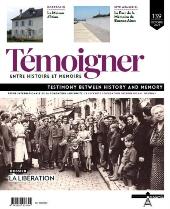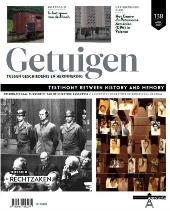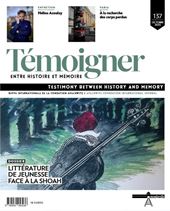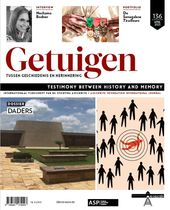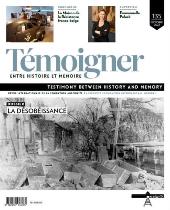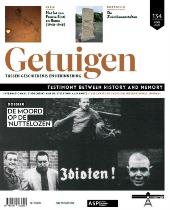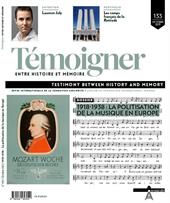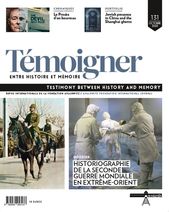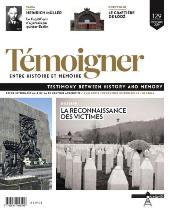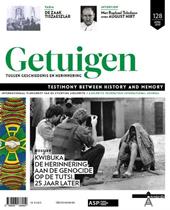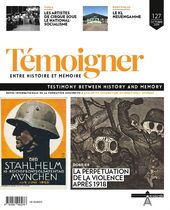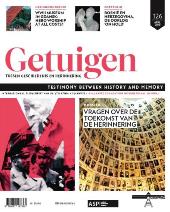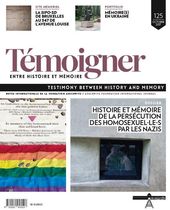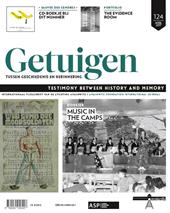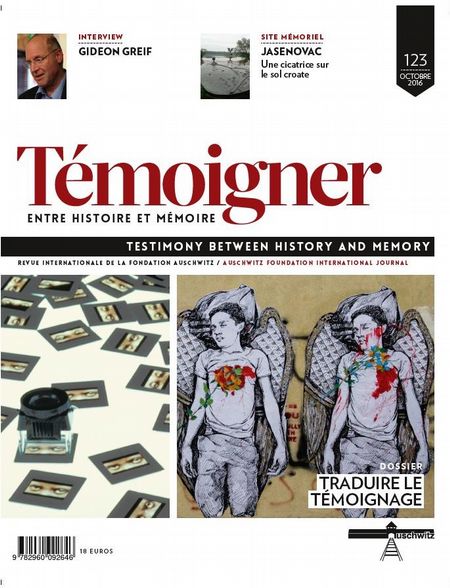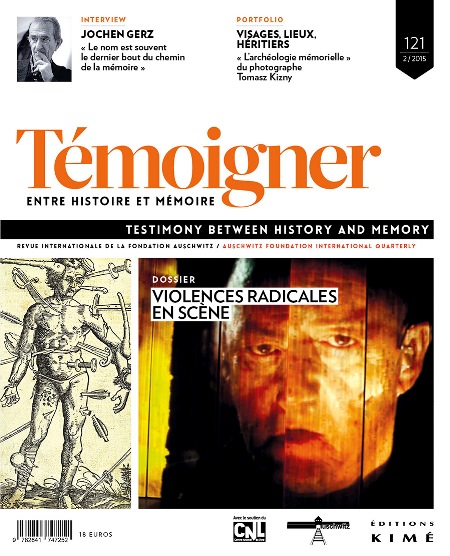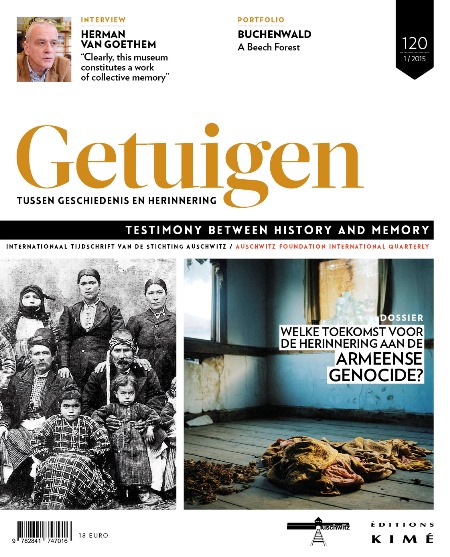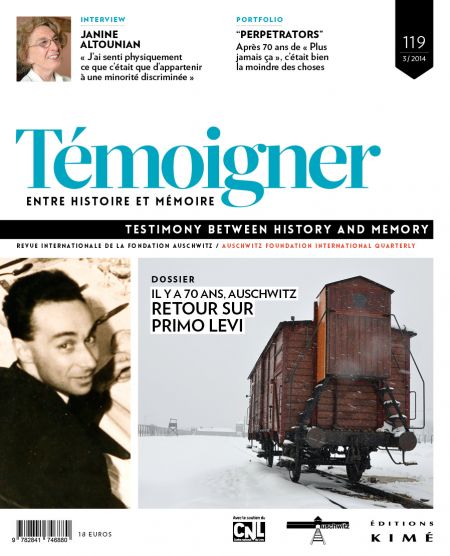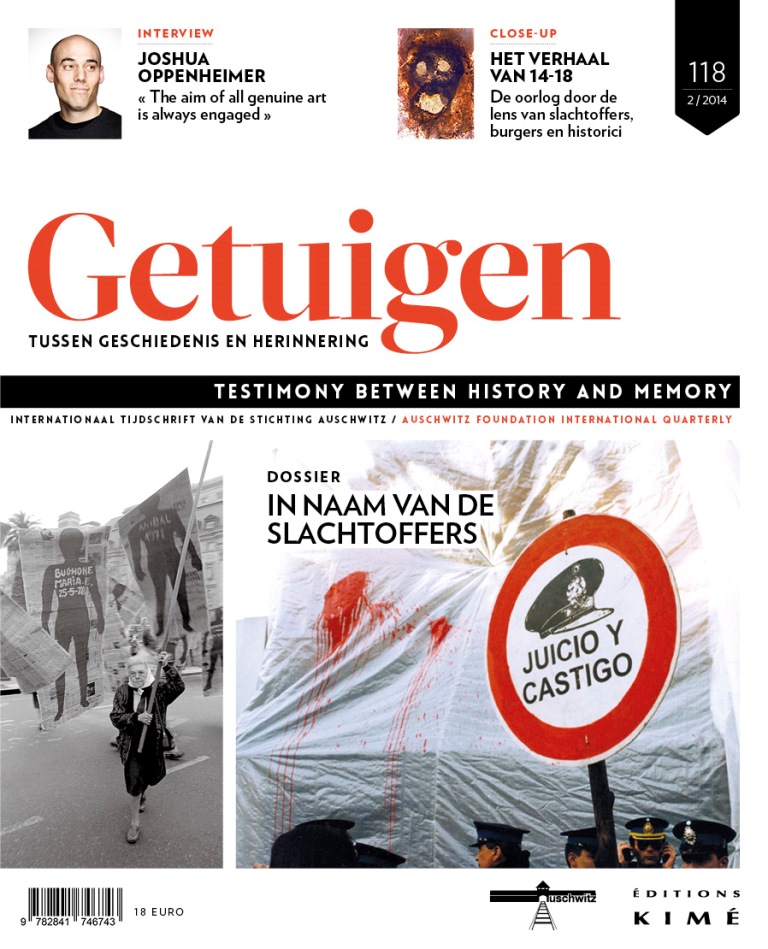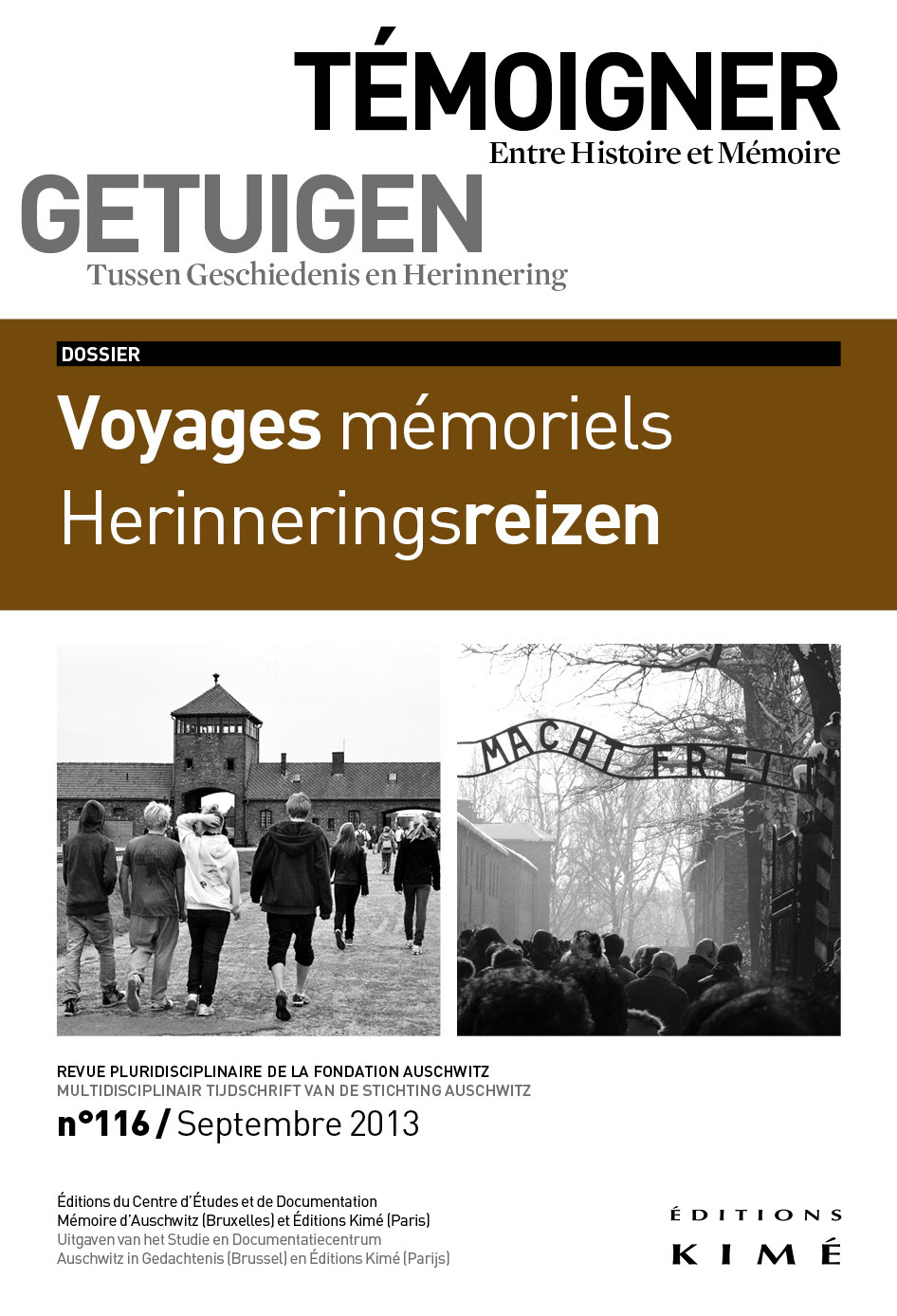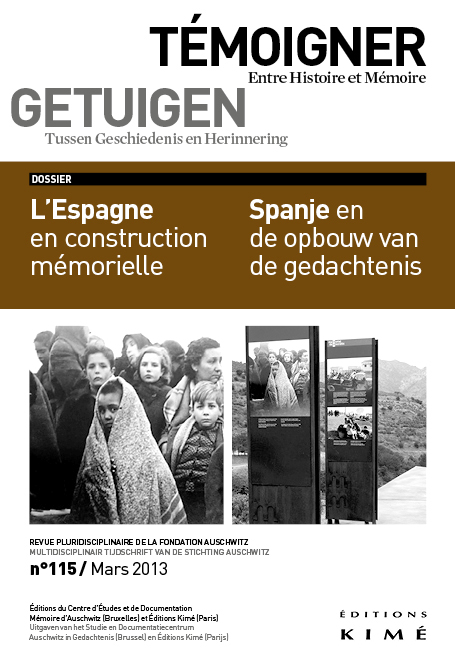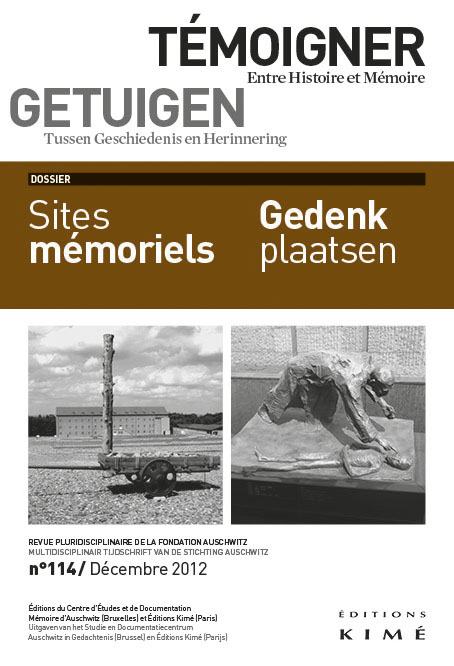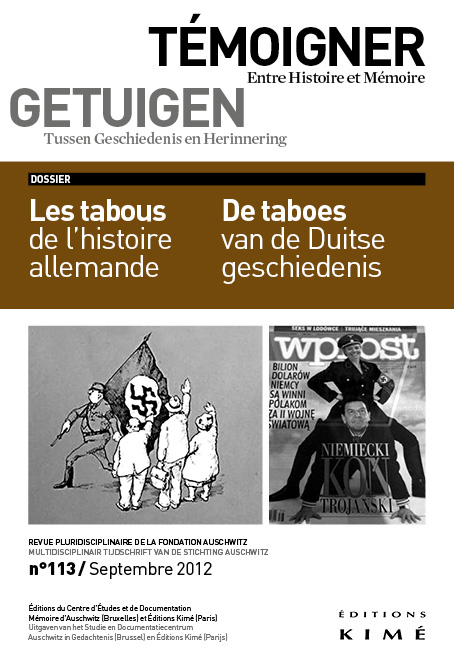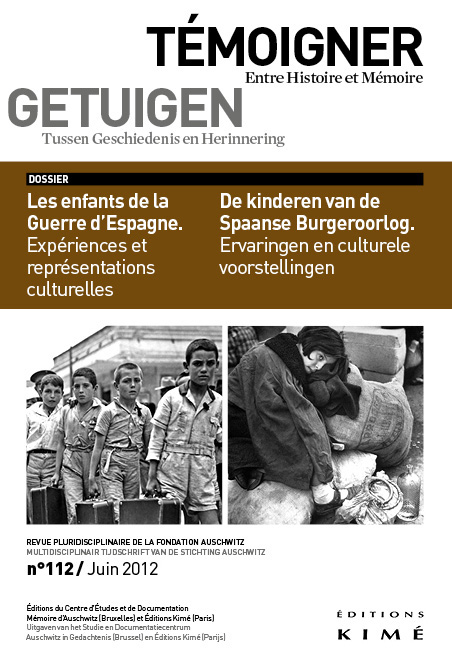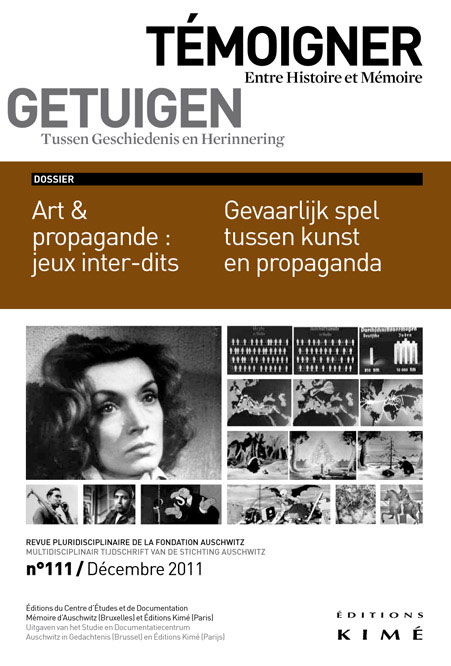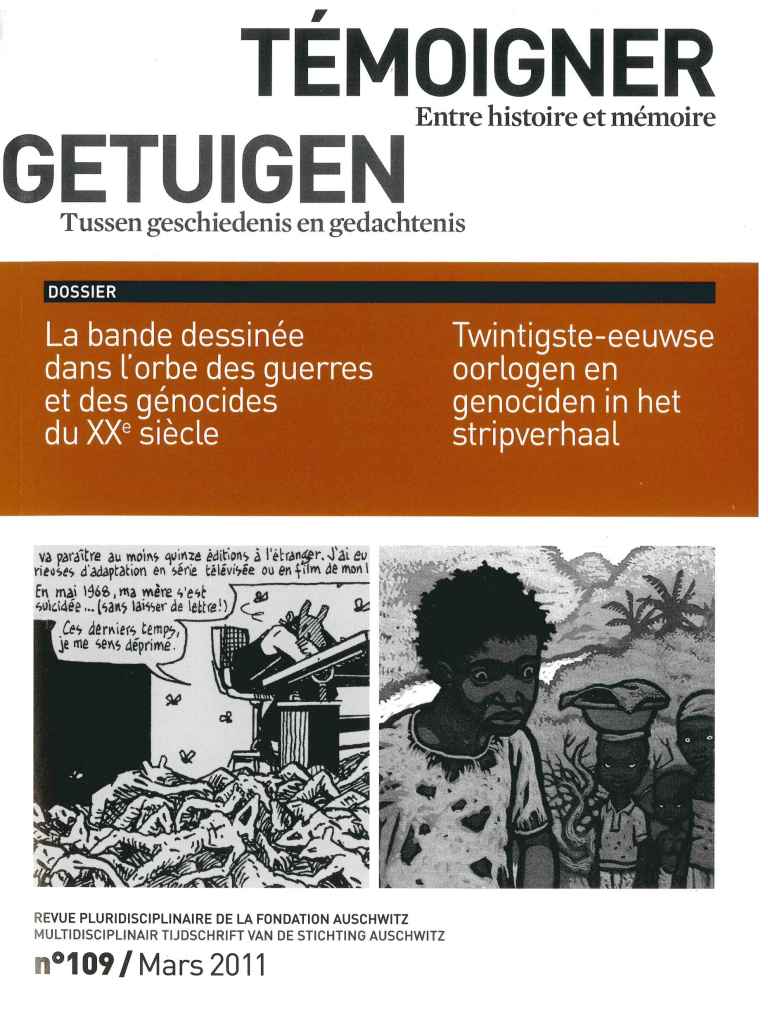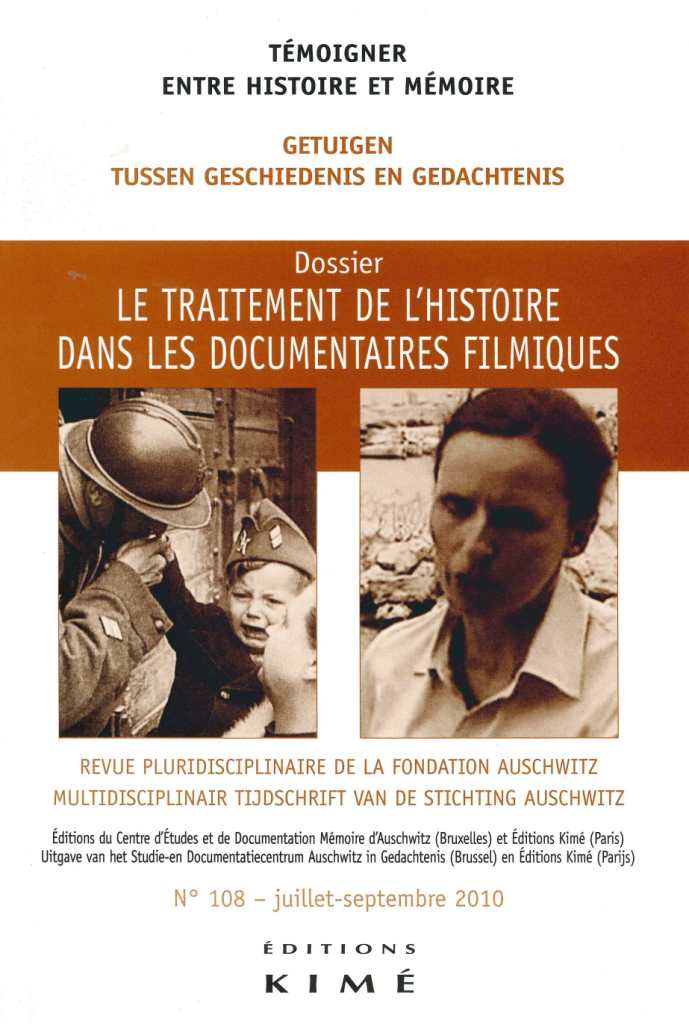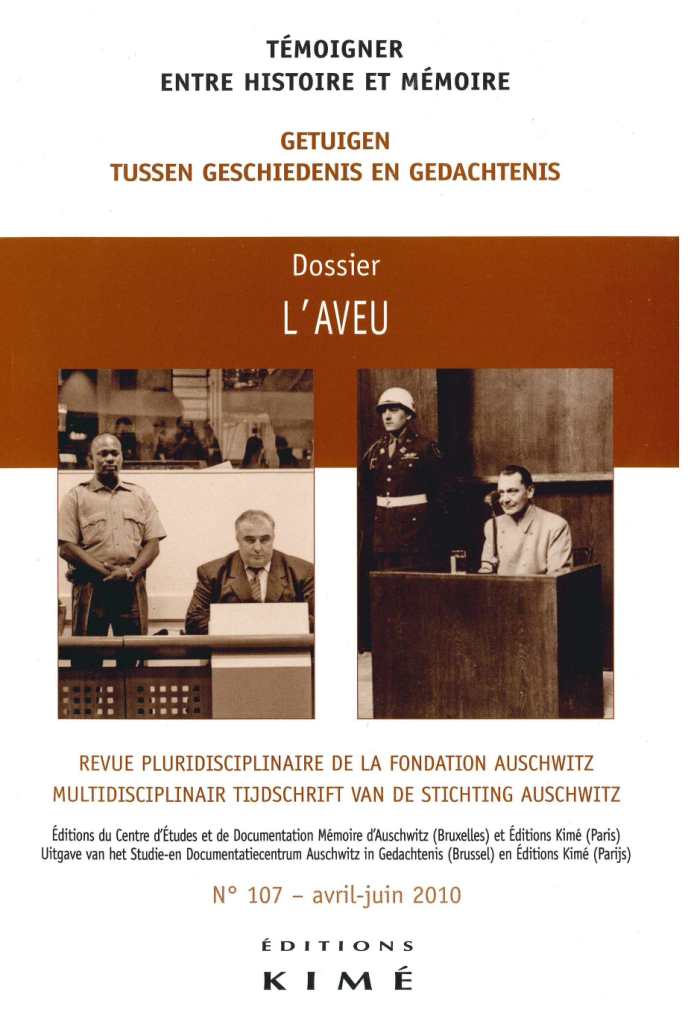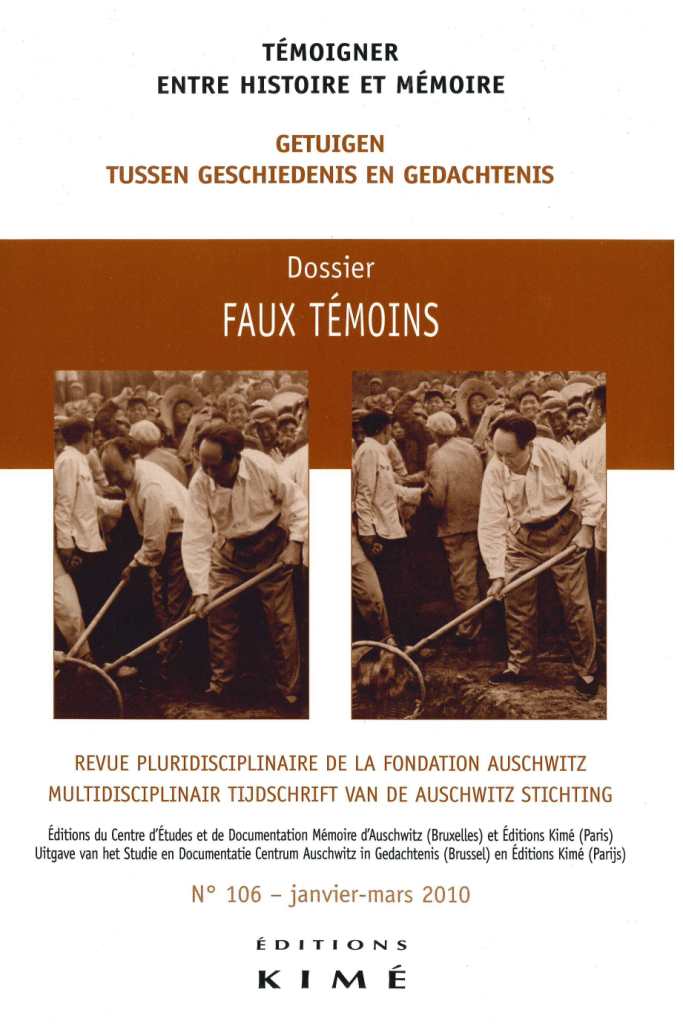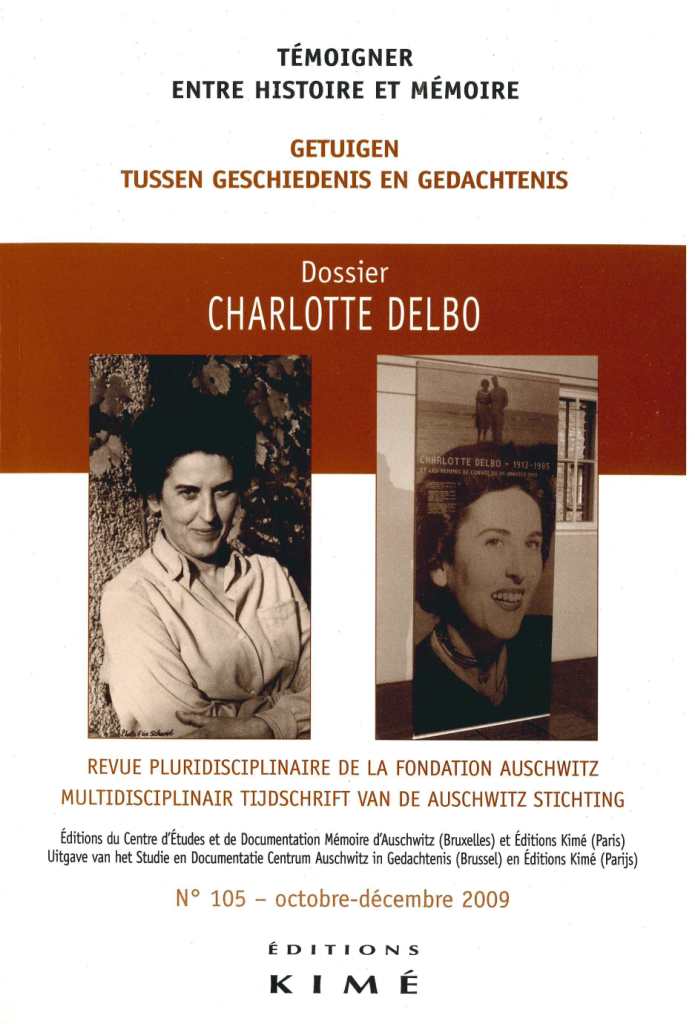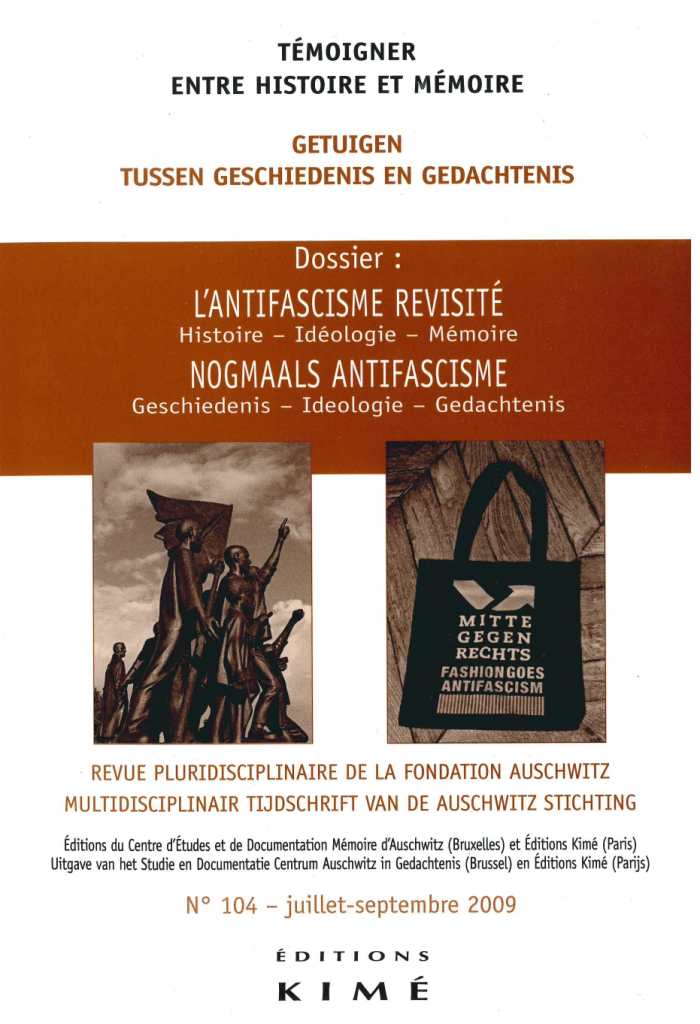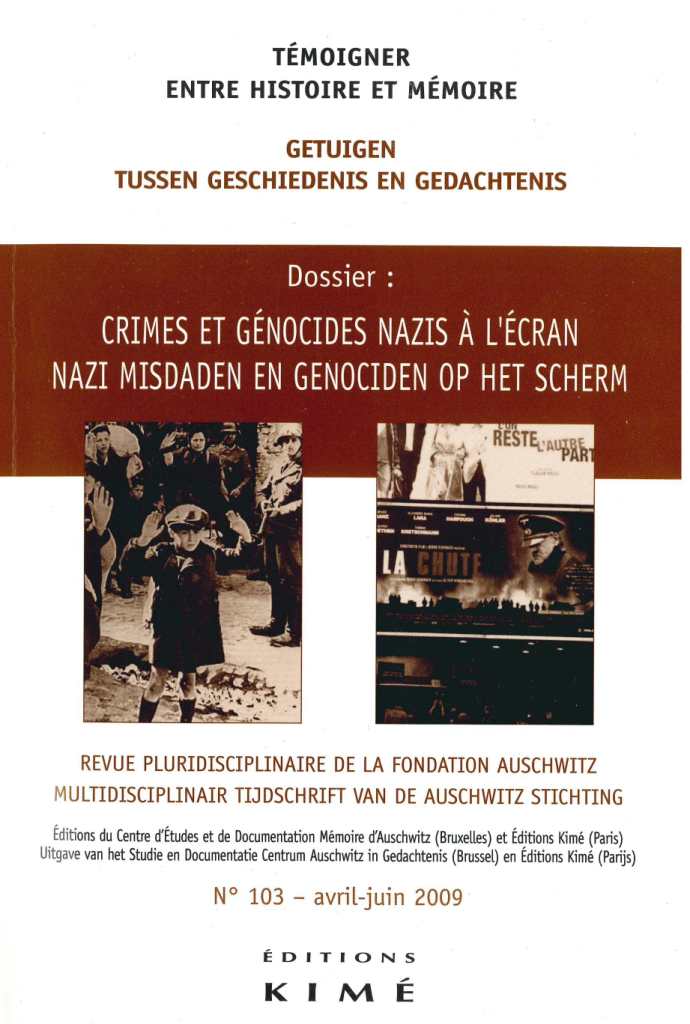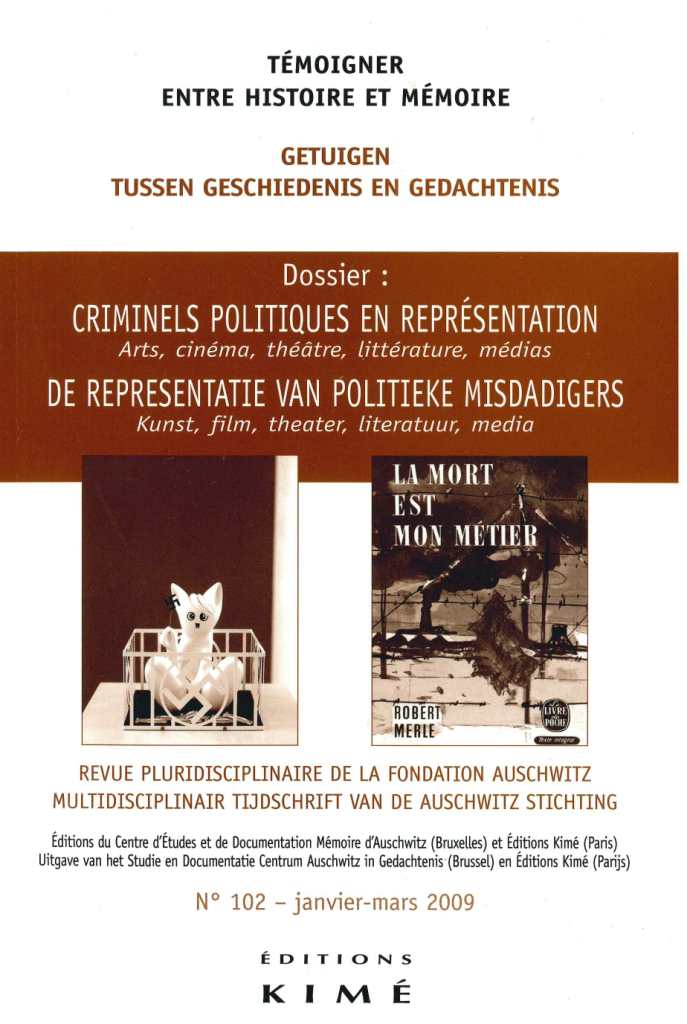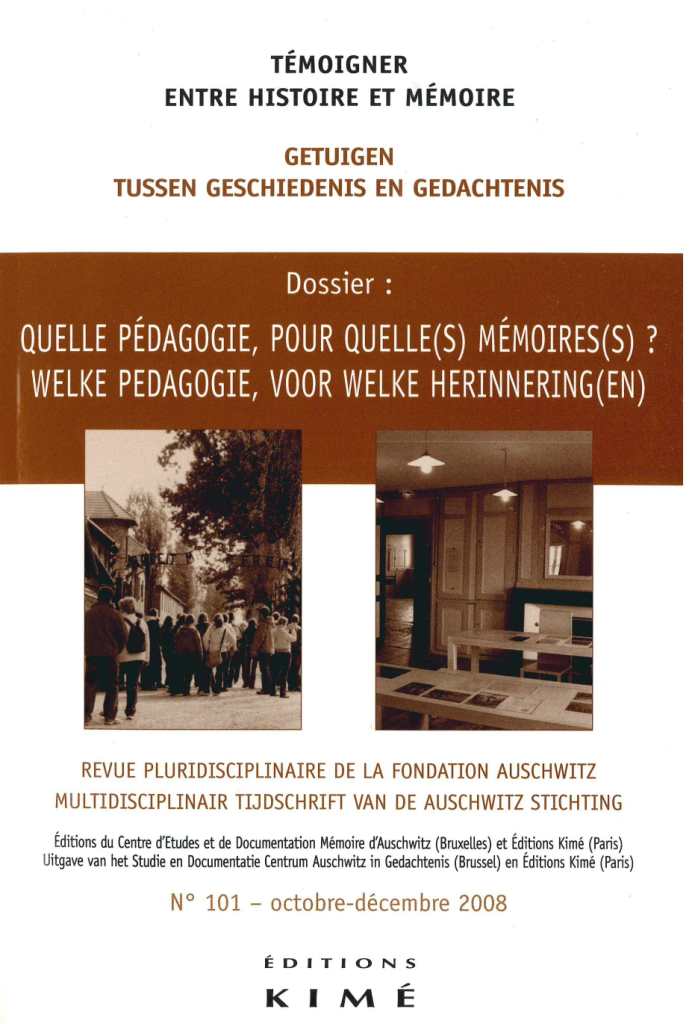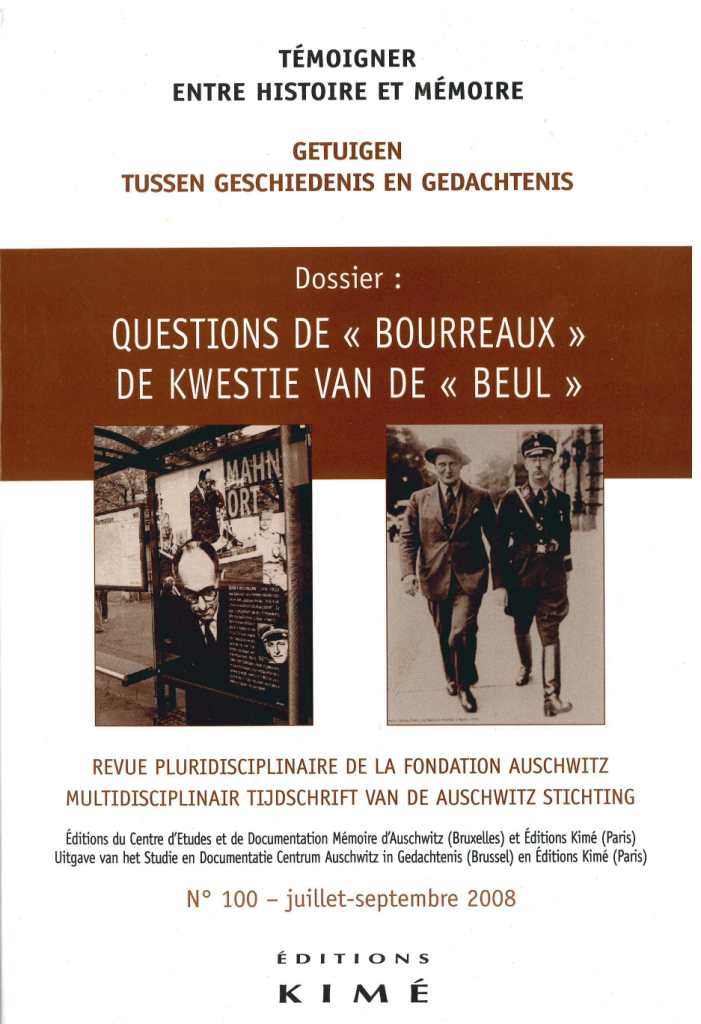Summary, abstract and full texts no. 109
Henri Goldberg and Philippe Mesnard: Editorial: In progress (in French - pdf)(in Dutch - pdf)
Dossier: La bande dessinée dans l'orbe des guerres et des génocides du XXe siècle
Coordinated by Fransiska Louwagie and Daniel Weyssow
Fransiska Louwagie and Daniel Weyssow: Presentation (in French - pdf)(in Dutch - pdf)
I. Propagande
Thierry Crépin: Les éditeurs de bandes dessinées en France sous l'occupation (pdf)
- During the 1940’s, the juvenile press was the main publishing medium for comic strips. The military defeat led to the emergence of new publishers, limited the circulation of the illustrated press, disrupted production centers and imposed submission to German and Vichy censorship. French publishers reacted to the unprecedented situation they faced in very different ways, ranging from compromise by established firms to a complacent acceptance of the "new times" by later arrivals.
- The art of propaganda, which consists of molding "good citizens", does everything in its power to unite hearts and minds and mobilize people around shared objectives. During the Second World War, Great Britain lived under the threat of invasion by the German enemy. The British government expected the population to make sacrifices, adapt to the demands of a period when penury was de rigueur and participate in the war effort. As entertaining supplements to radio broadcasts, cinema newsreels and articles published in the press, comic strips offered their readers an element of fantasy and consolation. They aimed not to frighten young people by making them anxious about the sufferings inflicted in totalitarian regimes, but rather to reassure them. But while their main purpose was to educate and entertain in wartime, comic strips also inevitably helped to inform, and to guide readers’ opinions.
- In 1942 the Dutch magazine Volk en Vaderland [People and Fatherland], the mouthpiece of the Dutch Nazi party which peddled the political beliefs propagated by the German occupier’s henchmen, published a weekly comic strip entitled "Rare, maar ware commentaren" ["Strange but true commentaries"]. In its 45 published and rather independent episodes its creator, Peter Beekman, commented on current events and developments. His portrayal of various "enemies" gives a picture of how the new publishing medium of the comic strip was used to inspire extreme racist attitudes. The main question examined in the article concerns the different stereotypes Beekman used to represent the Jews, his vision of the Jews and the possible impact of his antisemitic images. The article presents Beekman’s work in the context of the emergence of Dutch comic strips and analyzes the vivid presence of anti-Semitism in this specific case on the basis of six dominant themes.
II. Guerres et génocides du XXe siècle
- Hellé’s album bears witness to war according to the concept defined by Jean Norton Cru, by respecting unembroidered historical accuracy. It reflects the difficulty of describing a traumatic experience to children in a way which also commemorates that experience, and overcomes the difficulty by associating official statements from the belligerents’ headquarters with cryptic polychromic illustrations. Intertextuality is given prominence, while Hellé’s images are self-quotations relating to the toy-children characters in La Boîte à Joujoux, and the inter-iconography refers to photos from L’Illustration. The representation of the Great War corresponds to the sanctified image imprinted in collective memory, but temporal stratification filters the author’s personal view through the selected legends and texts, which act as frame for a panoramic image oscillating between primitive art and cartoon cinema. Illustrations tailored to a child audience play down the violence and achieve a miniaturization of the sublime.
- The Armenian genocide (1915-1916) has not featured strongly in the "ninth art", but its recent and increasingly emphatic recognition in the international arena has led to the publication of several comic strips on the subject between 1979 and 2010. At first these examined the Armenian question, subsequently showing the hovering shadow of genocide, and finally depicting the violence of the genocide itself in texts and images.
Yannick Malgouzou: Du récit familial au témoignage historique: Maus d'Art Spiegelman (pdf)
- "Maus" owes its critical and public success to the rigor of its approach, in which theory and practice, reflection and representation, question and enrich each other. Indeed, the author has created a dynamic form which transforms the narrative of an individual memory into the narrative of artistic creation. But this narrative of a difficult creation is in turn transformed into the narrative of a possible transmission of the experience of the genocide. These three narrative levels mix to display the difficulties of representation and communication inherent in the Jewish genocide, while at the same time showing how the work of art must transcend them by a set of aesthetic choices. So through the family narrative, Spiegelman builds a strongly individualized story, to which he gives a universal dimension by means of a set of strategies that exploit the resources of the comic strip.
Andreas Huyssen: Des souris ou des hommes ? La question de la mimesis d'Adorno à Spiegelman (pdf)
- Starting from the question of whether or not the Shoah can or should be represented, and from the flexibility of the concept of mimesis, Andreas Huyssen examines Art Spiegelman’s Maus as a work which has chosen to move as far as possible from the forms which are traditionally used for recounting a historical tragedy. In Spiegelman’s autobiographical work, the suicide of Artie’s mother figures as the event triggering Artie’s search for his origins, which leads him to question his father and then describe the years of wartime and deportations. The concept of mimesis, whose involvement in the process of civilization and paradoxical relationship to Bilderverbot (the prohibition of graven images) was postulated by Adorno, is used here as a means of overcoming the separation between the impossibility of expressing the events which the author/narrator wishes to express, and his need to escape from the state of melancholy in which he is plunged. In line with the tradition of US comics whose satirical aspect tends to wordplay such as "Mauschwitz", the author uses the portrayal of the characters as animals as an oblique approach to confronting his insurmountable feeling of loss.
Jonathan Haudot: Rire et Shoah: La réception de la BD Hitler=SS (pdf)
- In view of the scale of the tragedy, it may seem morally inappropriate, not to say antinomian, to associate the Shoah with laughter. But it has to be said that many artists, both Jewish and Gentile, have taken a humorous approach to the catastrophe. They include Romain Gary, Edgar Hilsenrath, and Roberto Benigni. In the case of Hitler = SS, a comic strip by Philippe Vuillemin and Jean-Marie Gourio, the reception in France was extremely hostile, its publisher and authors were accused and convicted of "racial insults" and "complicity in racial insults". This court case has only been described vaguely in comic strip history, so this article recounts and interprets the arguments put forward during the controversy and the trial resulting from the publication of Hitler = SS. Overall, the analysis sets out to explain the three major aspects of the album’s reception: the accused authors’ attempt to justify it by describing how it was conceived; the ambiguous interpretation of the work which resulted from its use of caricature and derision; and, finally, the implications of the way in which the album was disseminated.
Catherine Ojalvo: Séra face à la mémoire cambodgienne: le noir de la mémoire (pdf)
- Can the comic book, considered a priori as a "minor art", support and assume the role of testimony on the same level as the texts produced by Antelme, Kertesz or Levi? It is the validity of this question which we propose to consider in this contribution, by examining the productions of Séra, a Franco-Cambodian author of comic books who is also a painter and sculptor. We look at Séra’s portrayal of the genocide in three comic books which together form a sequence describing different periods of the Khmer Rouge regime in Cambodia. The analysis focuses in particular on the use of color throughout these comics.
- The fictional story portrayed in the graphic novel "Rwanda 1994 : Descente en Enfer" contains elements of the complex factual history of the Rwandan genocide. There are references in the text to both Rwanda’s heritage, which established the circumstances leading to the genocide, and France’s involvement in the "last genocide of the twentieth century". This article analyzes these allusions to the history of the Rwandan genocide as (re)presented in this unique literary medium.
- From April 6 to July 4, 1994, Rwanda was plunged in the turmoil of a genocide, but during that period the Western media were astonishingly silent on the subject. Indeed, it was not until August that the genocide became the main headline in Western magazines or newspapers. Since then films and graphic albums have seized on it, thus becoming involved in its mediatization and commemorative reconstruction. Why, and in what forms? Can suffering and death be treated as aesthetics? This article examines this question in terms of Jean-Philippe Stassen’s graphic novel "Déogratias" which raises the issue of commemorative construction in an original way. In "Déogratias" the artist has drawn on the techniques of journalism to tell the story of the Tutsi genocide and its social consequences. He chooses to focus his story/news report on the destiny of a young Hutu. From the viewpoint of historical investigation, following the career of this imaginary teenager makes it possible to reflect on the mechanisms of genocide and, above all, on the relationships between time and story, remembering and forgetting, and truth and subjectivity, and thus to show how a graphic album can play a part in building remembrance of the Tutsi genocide.
- Ari Folman and David Polonsky’s Waltz with Bashir: A Lebanon War Story (2009) represents a unique adaptation of a cinematic text into a graphic novel. Based on the eponymous award-winning animated documentary released a year earlier, the novel presents Folman’s autobiographical experience as a young Israeli soldier during the First Lebanon War (1982). This article contends that this adaptation subtly served the filmmaker to provide an amended testimony to his traumatic experience.
Varias
Christiane Hess: Félix Lazare Bertrand – Dessins du camp de Neuengamme (pdf)
- This article is a summary of the author’s master’s thesis. Art had a place in Neuengamme concentration camp, where a prisoner, Félix Lazare Bertrand, produced over 100 drawings. The article describes the conditions in which these drawings were created and also analyzes their social and communicative functions. After the war, the various uses made of the drawings gave rise to controversy.
Claudia Feld: Image, mémoire et disparition en Argentine (pdf)
- The forced disappearance of people, which became a systematic practice during Argentina’s last military dictatorship (1976-1983), may be defined as a series of actions carried by the armed forces and the security service: the abduction of designated individuals, their secret imprisonment, torture and murder, and the concealment of their corpses. To avoid leaving any visible traces of these actions, the army destroyed and hid documents which were likely to give rise to prosecutions. Nor are there any images documenting the conditions of the secret imprisonments and killings. Yet despite the lack of visual records, images played a central part in depicting and exposing these crimes, both during the dictatorship and subsequently. Thus, although the disappearances should have been the perfect way of wiping out all images, they nevertheless became known in Argentina and throughout the world thanks to images. What were those images? Who produced them? What issues of social memory do they raise? This article examines these questions on the basis of two works published recently in Argentina, by examining each audiovisual support studied separately: photography, documentary and fiction films and television. It is thus an initial approach to analyzing the complex relationship between memory, images and the disappearances which has developed in Argentina during the last 30 years.
Book reviews
- Janine Altounian, L’Intraduisible. Deuil, mémoire, transmission, Paris, Dunod, 2005 (pdf)
Review in French by Émilie Lochie - Henri Parens, Retour à la vie. Guérir de la Shoah, entre témoignage et résilience, Paris, Tallandier, 2010 (pdf)
Review in French by Adrien Beauduin - Louise L. Lambrichs, La littérature à l’épreuve du réel, Sarrebrück, Éd. Universitaires Européennes, 2010 (pdf)
Review in French by Marc Gjidara (Professor emeritus, University Panthéon-Assas – Paris II) - Bernard Sicot (coord.), La Littérature espagnole et les camps français d’internement (de 1939 à nos jours). Actes du colloque "70 años después", Université Paris-Ouest Nanterre-La Défense, Centre de recherches ibériques et latino-américaines, Groupe de recherches « Résistances et exils », 2010 (pdf)
Review in French by Geneviève Dreyfus-Armand - Actualité des revues historiques (pdf)
by Anne-Sophie Jacot (Department of Contemporary History at the Catholic University of Louvain-la-Neuve)
Contact
Auschwitz Foundation – Remembrance of Auschwitz
Rue aux Laines 17 box 50 – B-1000 Brussels +32 (0)2 512 79 98
+32 (0)2 512 79 98 info@auschwitz.be
info@auschwitz.be
BCE/KBO Auschwitz Foundation: 0876787354
BCE/KBO Remembrance of Auschwitz: 0420667323
Office open from Monday to Friday 9:30am to 4:30pm.
Visit only by appointment.
![]()
![]()
![]()
![]()
![]()
Become a member
To become a member of Remembrance of Auschwitz ASBL, please contact us and transfer the sum of €50.00 to our account IBAN: BE55 3100 7805 1744 – BIC: BBRUBEBB with the communication: ‘Membership fee 2025’. The membership includes two issues of 2025 of our scientific journal.
DONATIONS
Donations of €40.00 or more (in one or more instalments) qualify for tax exemption for Belgian taxpayers.
In communication, please specify that it is a ‘Donation’ and mention your National Number which is required since 2024 to benefit from the tax exemption.
Subscribe
Error : Please select some lists in your AcyMailing module configuration for the field "Automatically subscribe to" and make sure the selected lists are enabled


